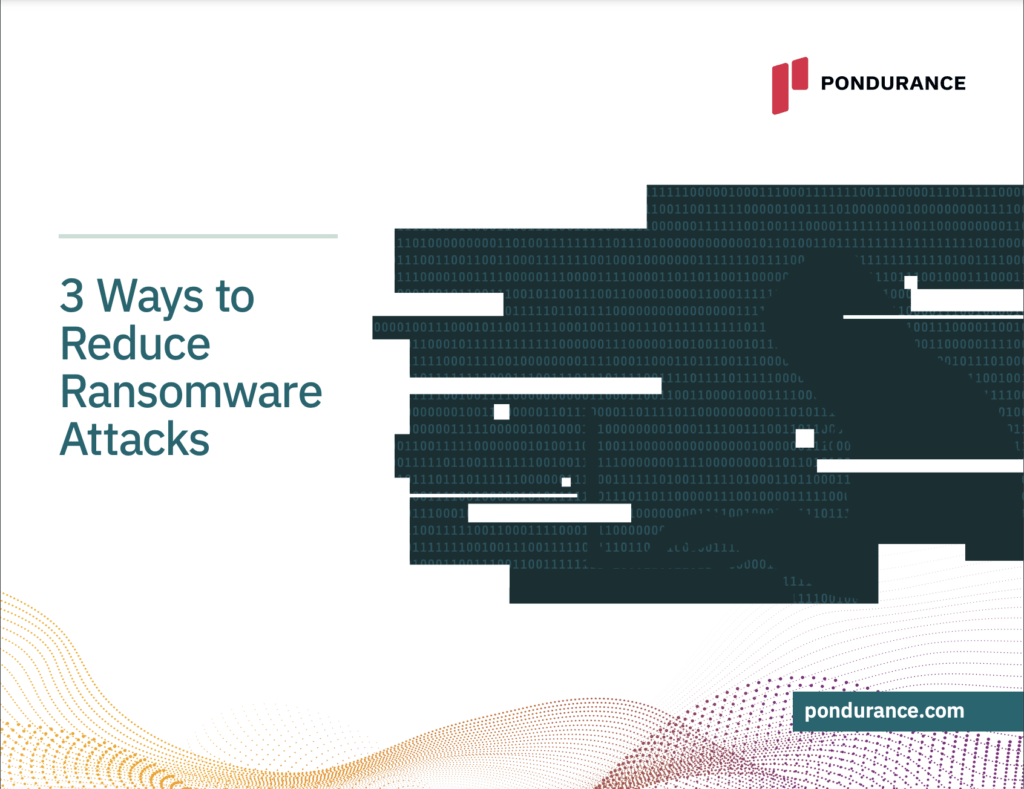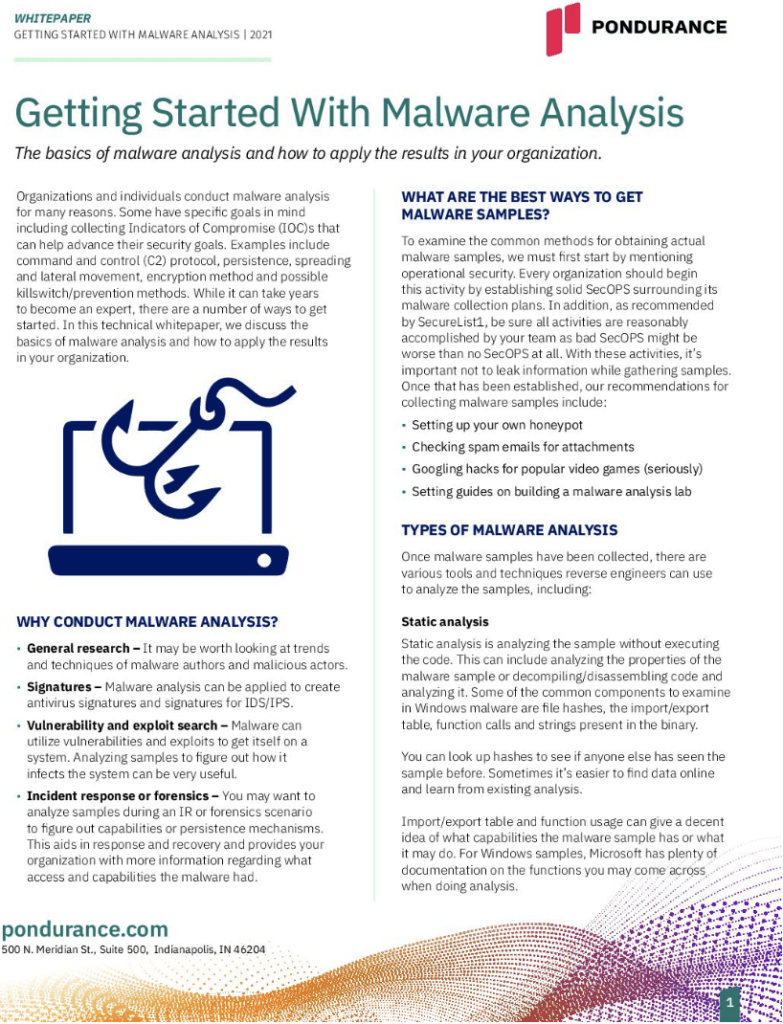Our privacy policy is located here.
Common Attack Vectors
And Keys to Protecting Your Business
Pondurance Helps Organizations to Manage Cyber Risk with its Risk-Based Approach
Learn how to combat cyber threats with Pondurance
Ransomware
- Keep all computers and devices patched
- Enable MFA
- Limit user access
- Allow only authorized applications
- Use network segmentation
- Limit remote access as much as possible
- Establish 360-degree visibility
- Monitor and analyze logs
- Provide consistent security awareness training
- Encrypt endpoints
Identify. Prioritize. Protect.
Malware
- Install reputable antivirus software and ensure it remains up to date
- Regularly update your operating system and all installed applications
- Enable built-in firewalls on your devices
- Be cautious of email attachments and links from unknown sources
- Utilize strong passwords and enable multifactor authentication (MFA) where possible
- Create regular backups of your important files and store them securely offsite
- Employee training – Educate staff members about potential threats such as phishing emails and social engineering tactics employed by cybercriminals
- Network segmentation – Divide your organization’s network into separate zones to minimize the spread of malware should an attack occur
- Vulnerability management – Regularly assess, identify, and remediate vulnerabilities in your IT infrastructure before they can be exploited by attackers
- Incident response planning – Develop a well-defined incident response plan outlining roles, responsibilities, and procedures to follow when faced with a security breach
Phishing
Additional Phishing Resources
Spear Phishing
Additional Spear Phishing Resources
Business Email Compromise (BEC)
Additional BEC Resources
Manage Cyber Risk
In the current digital age, cybersecurity companies play a pivotal role in addressing the ever-looming cyber risk. Cyber risk management is crucial for businesses to understand, encompassing the proactive assessment of potential cyber threats and the implementation of informed security measures to safeguard against data breaches, service interruptions, and cyber attacks. As organizations increasingly rely on digital infrastructure, the importance of robust cyber risk management strategies cannot be overstated.
IT Security Management is integral to cyber risk management, ensuring that security teams are equipped with the necessary tools and strategies to mitigate potential impacts of cybersecurity threats. Effective vulnerability management is key to reducing the likelihood of data breaches and bolstering an organization’s overall security posture. By adopting a risk-based approach to cybersecurity, businesses can prioritize resources towards managing potential threats in alignment with their risk management strategy, thereby optimizing their cyber resilience.
Pondurance stands out among cybersecurity companies, offering state-of-the-art solutions for cyber risk management. Their expertise lies in identifying and addressing potential vulnerabilities, providing organizations with the necessary guidance to navigate the complex landscape of cybersecurity threats. With Pondurance’s assistance, businesses can effectively manage cyber risk, minimizing the likelihood of data breaches and ensuring the resilience of their information systems against potential cyber threats. Leveraging Pondurance’s advanced threat intelligence and cyber threat assessment capabilities, organizations can fortify their security posture and safeguard sensitive data and information systems from evolving cyber threats in today’s dynamic digital environment.
Importance of Cyber Risk Management
It has become increasingly clear that the importance of cyber risk management cannot be underestimated in our progressively digitalized society. As an integral linchpin in any comprehensive corporate strategy, it effectively mitigates the potential harm that could befall businesses due to cyber threats and vulnerabilities. Effectively engaging with and maneuvering these digital pitfalls requires a well-informed, risk-based approach to cybersecurity.
Cyber risk encompasses a broad spectrum of potential issues, with the National Institute of Standards and Technology (NIST) providing a comprehensive cyber risk definition. NIST outlines cyber risk as a measure of the potential impact that a cybersecurity breach can have on an organization’s operations, assets, or individuals. Key areas it covers include unauthorized access, data breaches, hardware failures, and even physical damage from cyber-physical systems. Therefore, it is essential to have robust mechanisms in place to manage cyber risk.
The most efficient and effective way to manage cyber risk is to adopt a risk-based approach to cybersecurity. A risk-based approach analyzes the potential risks in an organization’s cybersecurity landscape and provides a strategic blueprint to mitigate these risks in proportion to their potential impact. For instance, in the field of risk-based cybersecurity, Pondurance is a leading figure, delivering services grounded on a comprehensive, risk-based approach, rather than simple checkbox compliance.
Managing cyber risk not only aids in aligning data protection measures with the business objectives but also maintains NIST CSF compliance, which is crucial as the cybersecurity compliance landscape continues to evolve. The holistic security framework provided by NIST enables organizations to manage cybersecurity risks in a cost-effective way while aligning with existing risk management and cybersecurity practices.
It is noteworthy in the discourse on cyber risk that organizations need to comprehend the enormous importance of cyber risk management. The advent of cyber threats to data protection, confidentiality, and business continuity emphasizes that organizations must arm themselves with effective cybersecurity compliance strategies. This importance is exponentially amplified in our modern economy, increasingly reliant on the digitization of records, transactions, and communications.
In summary, managing cyber risk is no longer a matter of choice but a fundamental necessity. Pondurance can serve as a prime example of how a risk-based approach to cybersecurity can be instrumental in safeguarding an organization’s present and securing its future.
The Cyber Risk Management Framework
Understandably intertwined with the surge in advanced technology and digitization in today’s businesses, cyber threats have immensely increased. A paramount contemporary concern, cyber threats are complex challenges that could result in grave damage if not effectively managed. Preparation and robust defense mechanisms against these threats are not just luxuries, but essential survival tools. The dominant way to navigate cyber threats efficiently lies in composite strategies like the cyber risk management framework.
The cyber risk management framework is an all-encompassing structure that guides organizations on how to manage cyber risk. This template integrates principles, practices, and procedures in an organized manner that fosters effective management, mitigation, and transfer of cyber threats. As a supplementary approach to cyber risk, it helps organizations identify potential points of vulnerability, evaluate possible impact, design effective cyber risk management policies, and, ultimately, ensure organizational sustainability in the face of possible digital attacks. A standout company leading the charge in the risk-based approach to cybersecurity is Pondurance. With a strong commitment to providing resilient cybersecurity solutions, Pondurance anchors its services on the cyber risk management framework, offering companies a reliable line of defense.
Fundamentals of the cyber risk management framework include cyber threat identification, assessment, mitigation, and monitoring. It is a cyclic concept that helps organizations perpetually monitor and improve their cyber risk resilience. It offers a solid structure in risk management in cybersecurity, emphasizing that cyber threats are challenges that cannot be totally eradicated but can be effectively managed. The framework’s functionality lies in its ability to provide a systematic yardstick for combating cybersecurity risk. By applying it, organizations can reduce the adverse impacts of cyber threats on their operations.
Pondurance, being a proactive leader in the industry, has articulated a seamless incorporation of the risk management framework into their offerings. Their client-centric cybersecurity services are testament to how managing cyber risk should be approached in the digital era. This approach prioritizes the protection of a company’s assets and the continuity of operations against a backdrop of tangible threats.
Risk Based Cybersecurity
Organizations are routinely grappling with prevalent cyber threats, necessitating a shift from reactive countermeasures to proactive and robust cyber risk management strategies. Central to this is the concept of “risk-based cybersecurity”, an established concept in the arsenal of digital protection that is fast gaining traction. This approach entails systemically identifying, assessing, and prioritizing cyber risks before implementing measures to mitigate or completely eradicate them.
Indeed, cyber threats transcend beyond hacking into systems; they encompass an array of perils including data breaches, denial of service (DDoS) attacks, and even ransomware. This range of threats clearly explains the concept of “inherent cyber risk”, referring to the widespread possibility of a cyber incident negatively affecting an organization’s position. This underscores the need to proactively manage these risks through a risk-based cyber security risk management approach.
Implementing a risk-based approach to cybersecurity is crucial to managing cyber risks. This strategy, as practiced by market leaders such as Pondurance, bears remarkable advantages for their clients. For one, it ensures resources are utilized judiciously focusing on areas with high vulnerability and probable impact. Furthermore, this approach allows organizations to predict potential threats and implement preventive measures to thwart the incipient danger, thereby reducing overall cyber risk exposure.
Pondurance, a beacon of risk-based managed cyber services, has optimally incorporated the principles of risk-based cybersecurity in their solutions for their clients. They serve as a reliable cyber risk advisory guide, collaborating with industry peers to adopt proven methodologies for assessing and managing cyber risks. To organizations, this is beneficial, not only because it insulates them from potential threats but also because it helps maintain their credibility, trust, and reputation among stakeholders by demonstrating due diligence in cybersecurity.
In today’s dynamic digital landscape, where cyber threats evolve rapidly, a proactive approach to cyber risk management is imperative for organizations to safeguard their assets and maintain operational continuity. By embracing the principles of risk-based cybersecurity and partnering with experienced providers like Pondurance, businesses can effectively navigate the complex cyber threat landscape and mitigate potential risks to their operations and reputation. Through strategic risk assessment, targeted mitigation measures, and ongoing monitoring, organizations can enhance their cyber resilience and adaptability in the face of evolving threats, ensuring long-term sustainability and success in the digital age.

